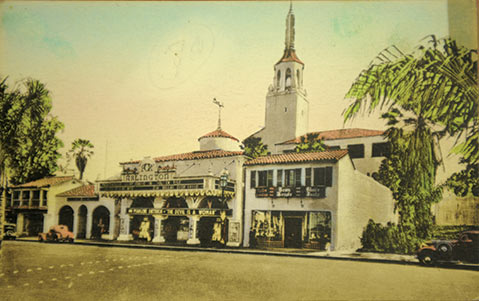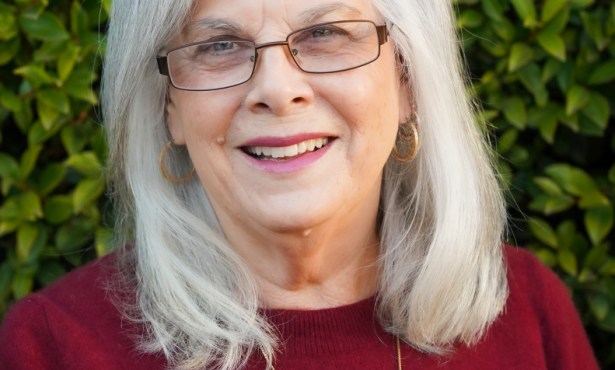Arlington Theatre’s Reel Good Legacy
Santa Barbara’s Historic Entertainment Venue Turns 85 This Week

Like many moviegoers, I’ll never forget my first visit to the Arlington Theatre: that majestic Spanish Colonial Revival profile, expansive courtyard, and glorious interior décor — rows of adobe houses along the theater’s perimeter with a night sky of constellations blanketing the ceiling, all like a scene straight out of an old Zorro motion picture. Even as a lifelong Angeleno who had frequented every movie palace in Hollywood, Santa Barbara’s largest theater impressed the hell out of me.
My first visit was July 1998 (long before my recent move to this area) on one of my myriad Santa Barbara weekend getaways. As we sat there waiting for the movie to begin, the crowd’s chatter stilled as the stage opened up before us, and out rose the pipe organ with an old organist playing like some whirling dervish to the animated summer audience’s emphatic delight. As this mad musician — still playing — slowly receded back down into the stage, I was practically transported back in time to turn-of-the-century California.
With all this magnificent fanfare preceding the opening credits, I’m embarrassed to tell you what movie I had come to town to see there: Godzilla, starring Matthew Broderick. Yes, while the warm memories of my inaugural visit will never fade, I can barely recall a single scene from Roland Emmerich’s failed reboot.
Unlike myself, city historian Mary Louise Days comes from several generations of Santa Barbarans. Days, who worked for the city’s Planning Department for 36 years until 1996, was born, raised, and educated here, even attending UC Santa Barbara. Ergo, the Arlington is part of her DNA.
“For many of us natives, it’s always been a part of our lives,” Days said.
The movie palace’s heritage is impressive, on a par with its spiritual siblings in Hollywood. As Santa Barbara Historical Museum Director of Research Michael Redmon explained, the perennial fixture on State Street’s 1300 block gleaned its name from two hotels previously occupying that spot: Santa Barbara’s first luxury hotel, The Arlington, which opened in 1875 before burning in a fire in 1909, and the New Arlington Hotel of 1911. The latter incarnation incurred so much damage in Santa Barbara’s great 1925 earthquake that it had to be demolished. Days speculated, “The second hotel had not been demolished immediately after the earthquake. I doubt that there was any interim use.” As the story was told to her, “My father [then 19] went downtown to get into a worker’s line of men trying to remove the brick rubble.”
Movie studios once controlled distribution, and so Twentieth Century Fox’s Fox West Coast Theatres Corporation intended to build a theater in town, in direct competition with the Granada Theatre, which was then owned by Warner Bros.
As legend has it, architect Joseph Plunkett of the Santa Barbara–based firm Edwards and Plunkett impressed West Coast Theatres executives with a few loose designs he had improvised on his Los Angeles trip. Fox executives immediately commissioned Edwards and Plunkett to design this new theater, which began construction in 1930.
Ornate, exotic-themed palaces were all the rage: Hollywood had Grauman’s Chinese Theatre, the Egyptian, and the Oriental; Oakland had the Paramount; and Fox established the Village, which still lords over Westwood and its UCLA constituents today. Plunkett pushed forward with what had become the architectural agenda of Santa Barbara’s civic leaders: a Spanish Colonial Revivalism, combining Spanish and Moorish motifs. Plunkett relied on the fountain in Seville to inform his design of the one in the Arlington’s esplanade and employed Tunisian tiles for the staircases, while hand-wrought-iron chandeliers and lamps took their cues from medieval Catalonian designs.
Artist Samuel Armstrong executed the mural over the entrance, while John Gamble oversaw the theater’s spectacular Spanish village interior design (replete with painted streetlight shadows) and the Andalusian landscape across the fire curtain.
On May 22, 1931, the world premiere of Fox’s Daddy Long Legs launched the Fox Arlington, attracting Daddy stars Janet Gaynor and Warner Baxter plus Myrna Loy, Joan Bennett, and Wallace Beery.
“I grew up with it being the Fox. We never called it the Arlington,” said Days, who, as a child, caught musicals, Doris Day comedies, and (every Easter) silent movie King of Kings there. She remembers beholding with wonder “this beautiful Spanish village, looking up at the stars. After the movie, when we’d come out [into daylight], I’d be momentarily confused.
“I still love going up there,” continued Days, who attended the Arlington’s 50th anniversary gala in 1981. “Much later, working for the city, there was some concern about the condition of the theater.”
According to Redmon, in the 1940s, the then-1,800-seater entered hard times, continuing into the 1950s with the advent of television. Fox let its Arlington lease lapse, and Metropolitan Theatres Corporation (the 1923-formed, Corwin-family-run chain) picked it up. In 1975, Metropolitan purchased the theater from owner Earl W. Huntley, investing $500,000 into restoring the venerable venue.
Since the Santa Barbara International Film Festival’s inception 31 years ago, and certainly during Roger Durling’s 14 years as executive director, the Arlington has been SBIFF’s principal home.
“We use it for opening night and closing night. We use it every night,” Durling said.
That includes a Johnny Depp tribute, Boyhood stars Ethan Hawke and Patricia Arquette last year, and an homage to Spotlight actors Michael Keaton and Rachel McAdams in February.
Durling has interviewed many actors on the Arlington’s stage, including Penélope Cruz and her husband, Javier Bardem, as well as The Artist star Jean Dujardin (on a stage once welcoming live acts Mae West and the Marx Brothers). Bardem — his first time inside the 2,200-seater — “was overwhelmed by how big and cavernous it was from the stage. It’s an extremely hospitable environment.”
It’s even more hospitable now to visiting celebrities, as the green rooms and bathrooms backstage received “a much-needed uplift a number of years ago,” Durling continued.
The very design of the award that SBIFF hands to such actors as Keaton and McAdams is modeled after the Arlington’s tower. “It really represents Santa Barbara,” Durling said.
Every year, Durling and his staff pick a big summer blockbuster to view there. But it’s not just moviegoers who want to see their films there — it’s also the moviemakers.
“Robert Zemeckis, James Cameron, and Quentin Tarantino are extremely fond of that venue,” Durling said. “When [Zemeckis’s] last feature, The Walk, premiered, he really wanted it to be shown there.”
Ditto Cameron in 2009 with Avatar.
Yeah, Hollywood’s Godzilla remakes come and go — 2014’s broke big; the sequel arrives in 2018. Fingers crossed that the Arlington, the King Kong of Santa Barbara movie theaters, stays with us for at least another 85 years.



